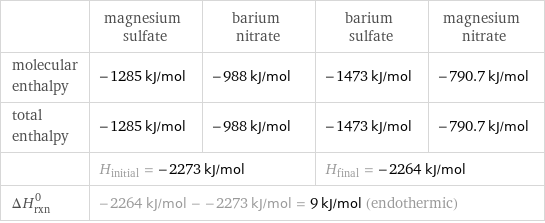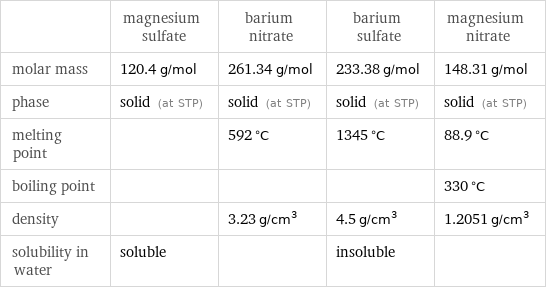Input interpretation

MgSO_4 magnesium sulfate + Ba(NO_3)_2 barium nitrate ⟶ BaSO_4 barium sulfate + Mg(NO_3)_2 magnesium nitrate
Balanced equation

Balance the chemical equation algebraically: MgSO_4 + Ba(NO_3)_2 ⟶ BaSO_4 + Mg(NO_3)_2 Add stoichiometric coefficients, c_i, to the reactants and products: c_1 MgSO_4 + c_2 Ba(NO_3)_2 ⟶ c_3 BaSO_4 + c_4 Mg(NO_3)_2 Set the number of atoms in the reactants equal to the number of atoms in the products for Mg, O, S, Ba and N: Mg: | c_1 = c_4 O: | 4 c_1 + 6 c_2 = 4 c_3 + 6 c_4 S: | c_1 = c_3 Ba: | c_2 = c_3 N: | 2 c_2 = 2 c_4 Since the coefficients are relative quantities and underdetermined, choose a coefficient to set arbitrarily. To keep the coefficients small, the arbitrary value is ordinarily one. For instance, set c_1 = 1 and solve the system of equations for the remaining coefficients: c_1 = 1 c_2 = 1 c_3 = 1 c_4 = 1 Substitute the coefficients into the chemical reaction to obtain the balanced equation: Answer: | | MgSO_4 + Ba(NO_3)_2 ⟶ BaSO_4 + Mg(NO_3)_2
Structures

+ ⟶ +
Names

magnesium sulfate + barium nitrate ⟶ barium sulfate + magnesium nitrate
Reaction thermodynamics
Enthalpy

| magnesium sulfate | barium nitrate | barium sulfate | magnesium nitrate molecular enthalpy | -1285 kJ/mol | -988 kJ/mol | -1473 kJ/mol | -790.7 kJ/mol total enthalpy | -1285 kJ/mol | -988 kJ/mol | -1473 kJ/mol | -790.7 kJ/mol | H_initial = -2273 kJ/mol | | H_final = -2264 kJ/mol | ΔH_rxn^0 | -2264 kJ/mol - -2273 kJ/mol = 9 kJ/mol (endothermic) | | |
Gibbs free energy

| magnesium sulfate | barium nitrate | barium sulfate | magnesium nitrate molecular free energy | -1171 kJ/mol | -7926 kJ/mol | -1362 kJ/mol | -589.4 kJ/mol total free energy | -1171 kJ/mol | -7926 kJ/mol | -1362 kJ/mol | -589.4 kJ/mol | G_initial = -9097 kJ/mol | | G_final = -1952 kJ/mol | ΔG_rxn^0 | -1952 kJ/mol - -9097 kJ/mol = 7145 kJ/mol (endergonic) | | |
Equilibrium constant
![Construct the equilibrium constant, K, expression for: MgSO_4 + Ba(NO_3)_2 ⟶ BaSO_4 + Mg(NO_3)_2 Plan: • Balance the chemical equation. • Determine the stoichiometric numbers. • Assemble the activity expression for each chemical species. • Use the activity expressions to build the equilibrium constant expression. Write the balanced chemical equation: MgSO_4 + Ba(NO_3)_2 ⟶ BaSO_4 + Mg(NO_3)_2 Assign stoichiometric numbers, ν_i, using the stoichiometric coefficients, c_i, from the balanced chemical equation in the following manner: ν_i = -c_i for reactants and ν_i = c_i for products: chemical species | c_i | ν_i MgSO_4 | 1 | -1 Ba(NO_3)_2 | 1 | -1 BaSO_4 | 1 | 1 Mg(NO_3)_2 | 1 | 1 Assemble the activity expressions accounting for the state of matter and ν_i: chemical species | c_i | ν_i | activity expression MgSO_4 | 1 | -1 | ([MgSO4])^(-1) Ba(NO_3)_2 | 1 | -1 | ([Ba(NO3)2])^(-1) BaSO_4 | 1 | 1 | [BaSO4] Mg(NO_3)_2 | 1 | 1 | [Mg(NO3)2] The equilibrium constant symbol in the concentration basis is: K_c Mulitply the activity expressions to arrive at the K_c expression: Answer: | | K_c = ([MgSO4])^(-1) ([Ba(NO3)2])^(-1) [BaSO4] [Mg(NO3)2] = ([BaSO4] [Mg(NO3)2])/([MgSO4] [Ba(NO3)2])](../image_source/d7fe011397ae25a202c7d8b476082469.png)
Construct the equilibrium constant, K, expression for: MgSO_4 + Ba(NO_3)_2 ⟶ BaSO_4 + Mg(NO_3)_2 Plan: • Balance the chemical equation. • Determine the stoichiometric numbers. • Assemble the activity expression for each chemical species. • Use the activity expressions to build the equilibrium constant expression. Write the balanced chemical equation: MgSO_4 + Ba(NO_3)_2 ⟶ BaSO_4 + Mg(NO_3)_2 Assign stoichiometric numbers, ν_i, using the stoichiometric coefficients, c_i, from the balanced chemical equation in the following manner: ν_i = -c_i for reactants and ν_i = c_i for products: chemical species | c_i | ν_i MgSO_4 | 1 | -1 Ba(NO_3)_2 | 1 | -1 BaSO_4 | 1 | 1 Mg(NO_3)_2 | 1 | 1 Assemble the activity expressions accounting for the state of matter and ν_i: chemical species | c_i | ν_i | activity expression MgSO_4 | 1 | -1 | ([MgSO4])^(-1) Ba(NO_3)_2 | 1 | -1 | ([Ba(NO3)2])^(-1) BaSO_4 | 1 | 1 | [BaSO4] Mg(NO_3)_2 | 1 | 1 | [Mg(NO3)2] The equilibrium constant symbol in the concentration basis is: K_c Mulitply the activity expressions to arrive at the K_c expression: Answer: | | K_c = ([MgSO4])^(-1) ([Ba(NO3)2])^(-1) [BaSO4] [Mg(NO3)2] = ([BaSO4] [Mg(NO3)2])/([MgSO4] [Ba(NO3)2])
Rate of reaction
![Construct the rate of reaction expression for: MgSO_4 + Ba(NO_3)_2 ⟶ BaSO_4 + Mg(NO_3)_2 Plan: • Balance the chemical equation. • Determine the stoichiometric numbers. • Assemble the rate term for each chemical species. • Write the rate of reaction expression. Write the balanced chemical equation: MgSO_4 + Ba(NO_3)_2 ⟶ BaSO_4 + Mg(NO_3)_2 Assign stoichiometric numbers, ν_i, using the stoichiometric coefficients, c_i, from the balanced chemical equation in the following manner: ν_i = -c_i for reactants and ν_i = c_i for products: chemical species | c_i | ν_i MgSO_4 | 1 | -1 Ba(NO_3)_2 | 1 | -1 BaSO_4 | 1 | 1 Mg(NO_3)_2 | 1 | 1 The rate term for each chemical species, B_i, is 1/ν_i(Δ[B_i])/(Δt) where [B_i] is the amount concentration and t is time: chemical species | c_i | ν_i | rate term MgSO_4 | 1 | -1 | -(Δ[MgSO4])/(Δt) Ba(NO_3)_2 | 1 | -1 | -(Δ[Ba(NO3)2])/(Δt) BaSO_4 | 1 | 1 | (Δ[BaSO4])/(Δt) Mg(NO_3)_2 | 1 | 1 | (Δ[Mg(NO3)2])/(Δt) (for infinitesimal rate of change, replace Δ with d) Set the rate terms equal to each other to arrive at the rate expression: Answer: | | rate = -(Δ[MgSO4])/(Δt) = -(Δ[Ba(NO3)2])/(Δt) = (Δ[BaSO4])/(Δt) = (Δ[Mg(NO3)2])/(Δt) (assuming constant volume and no accumulation of intermediates or side products)](../image_source/1335301dda67f502364acaf435f8f9aa.png)
Construct the rate of reaction expression for: MgSO_4 + Ba(NO_3)_2 ⟶ BaSO_4 + Mg(NO_3)_2 Plan: • Balance the chemical equation. • Determine the stoichiometric numbers. • Assemble the rate term for each chemical species. • Write the rate of reaction expression. Write the balanced chemical equation: MgSO_4 + Ba(NO_3)_2 ⟶ BaSO_4 + Mg(NO_3)_2 Assign stoichiometric numbers, ν_i, using the stoichiometric coefficients, c_i, from the balanced chemical equation in the following manner: ν_i = -c_i for reactants and ν_i = c_i for products: chemical species | c_i | ν_i MgSO_4 | 1 | -1 Ba(NO_3)_2 | 1 | -1 BaSO_4 | 1 | 1 Mg(NO_3)_2 | 1 | 1 The rate term for each chemical species, B_i, is 1/ν_i(Δ[B_i])/(Δt) where [B_i] is the amount concentration and t is time: chemical species | c_i | ν_i | rate term MgSO_4 | 1 | -1 | -(Δ[MgSO4])/(Δt) Ba(NO_3)_2 | 1 | -1 | -(Δ[Ba(NO3)2])/(Δt) BaSO_4 | 1 | 1 | (Δ[BaSO4])/(Δt) Mg(NO_3)_2 | 1 | 1 | (Δ[Mg(NO3)2])/(Δt) (for infinitesimal rate of change, replace Δ with d) Set the rate terms equal to each other to arrive at the rate expression: Answer: | | rate = -(Δ[MgSO4])/(Δt) = -(Δ[Ba(NO3)2])/(Δt) = (Δ[BaSO4])/(Δt) = (Δ[Mg(NO3)2])/(Δt) (assuming constant volume and no accumulation of intermediates or side products)
Chemical names and formulas

| magnesium sulfate | barium nitrate | barium sulfate | magnesium nitrate formula | MgSO_4 | Ba(NO_3)_2 | BaSO_4 | Mg(NO_3)_2 Hill formula | MgO_4S | BaN_2O_6 | BaO_4S | MgN_2O_6 name | magnesium sulfate | barium nitrate | barium sulfate | magnesium nitrate IUPAC name | magnesium sulfate | barium(+2) cation dinitrate | barium(+2) cation sulfate | magnesium dinitrate
Substance properties

| magnesium sulfate | barium nitrate | barium sulfate | magnesium nitrate molar mass | 120.4 g/mol | 261.34 g/mol | 233.38 g/mol | 148.31 g/mol phase | solid (at STP) | solid (at STP) | solid (at STP) | solid (at STP) melting point | | 592 °C | 1345 °C | 88.9 °C boiling point | | | | 330 °C density | | 3.23 g/cm^3 | 4.5 g/cm^3 | 1.2051 g/cm^3 solubility in water | soluble | | insoluble |
Units
